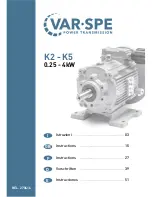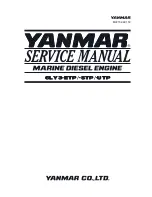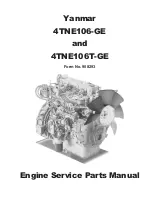
17
MS Motors
Selection
Motor Operation
Most deep well submersible type pumps are powered
by electric motors. The optimum power unit used is
dependent on several physical and environmental
factors, which include the horsepower required for
pumping, the annual hours of operation and the avail-
ability and cost of energy.
How does a motor "know" what horsepower to deliver?
Electric motors draw power in proportion to the applied
load. Although a motor is rated for a certain output
power (this is the number stamped on the nameplate),
that motor can deliver a wide range of power depending
on the voltage and frequency provided and the torque
demanded by the shaft load.
Power is the rate of energy use. Input power to a elec-
trical motor is measured in kW, the motor converts that
electric power into mechanical power.
Output power is the product of speed (rpm) and torque
(ft.-lb.). For a given voltage and frequency combination,
the motor will always operate at a point on a specific
torque vs. speed curve.
The units of both output power and torque are generally
specified as a percentage of the motors full load rated
value on the manufactures performance curve.
A small change in speed produce large changes in
available torque near the normal (close to rated) oper-
ating speed.
Thus as load torque increases, the rotational speed will
drop slightly (increased slip) as the motor load
increases.
As soon as voltage is supplied to the motor, the motor
“knows” the power to deliver by speeding up until it puts
out exactly the same torque as the load requires at that
speed.
At start-up, the motor produces torque higher than the
torque required by the driven load, accelerating the
pump shaft to full load speed.
A submersible pump is a centrifugal device which
exhibits variable torque load characteristics, it takes
very little torque to accelerate the load at low speed.
A centrifugal pump requires torque approximately
proportional to the square of its speed. The maximum
speed of a induction motor is a function of the number
of poles and line frequency.
Typical speeds associated with submersible motors,
based on the number of poles and a line frequency of
60 Hz are; 2p - 3600 rpm (sync.)/ 3450 rpm (@ full load)
and 4p - 1800 rpm (sync.)/ 1760 (@ full load).
The synchronous speed on any motor can be calcu-
lated when the number of poles and operating
frequency is known, using the formula below:
N = f x 120/P
where; N = sync. speed (rpm),
P
= poles,
f
= frequency (Hz)
Note:
Actual induction motor speed at full load will be
2-5% less than the synchronous speed calculated using
the formula above.
A pump driven by two different motors of the same
nominal speed (rpm), but different Hp ratings, will draw
approximately the same power.
Under steady-state conditions the speed of operation
does not change significantly, unless the motor is too
small and stalls.
Motor Loading, Failure
and Lifetime
Motor load is commonly expressed as the percentage
of output power to rated output. Because output power
(load) is difficult to measure in the field, motor load is
usually estimated by measuring input power (kWI) and
assuming an efficiency.
It can also be estimated by measuring kVA and
assuming both power factor and efficiency. Failure of a
motor occurs when insulation breaks down from heat
and mechanical stresses.
The temperature of the windings are primarily depen-
dent on the current (amps) draw through them and the
ability of motor to dissipate the heat generated to the
ambient environment. The higher the temperature, the
shorter the life. A 10°C(50F) rise can halve motor life.
Motor current draw increases with load; as a result,
motors that operate outside established load and
temperature ratings, will operate fewer hours before
failure.
The voltage supplied to the motor terminals have a
significant impact on motor life.
Motors are designed to operate at a utilization voltage
level or range, which is generally lower than the elec-
trical system distribution voltage provided to the utility
meter. Motors can operate within a range of voltages;
but above a certain voltage, destructive arcing and
insulation deterioration can occur.
Conversely, as voltage drops, more current is needed
to maintain torque and power; so the motor runs hotter
and its life is shortened.
In addition to the overall voltage provided to the motor,
voltage unbalance must be considered. If the voltages
on the three phases to the motor are not well balanced,
one winding will carry more current and may over heat
and fail.
MS.book Page 17 Wednesday, January 26, 2005 3:25 PM
Summary of Contents for MS 4000
Page 1: ...GRUNDFOS PRODUCT GUIDE MS Submersible Motors 60 Hz...
Page 47: ...47...
















































